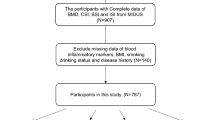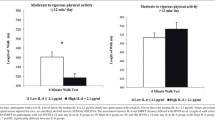Abstract
Chronic, low-grade systematic inflammation has been associated with bone loss and increased fracture risk. We previously reported that exercise improved femoral neck bone mineral density (BMD), geometry and strength and lumbar spine trabecular BMD in middle-aged and older men, but had no effect on markers of inflammation. The aim of this study was to examine the association between basal inflammatory status and the adaptive skeletal responses to exercise. Secondary analysis was completed on 91 men aged 50–79 years who participated in an 18-month program of progressive resistance training plus weight-bearing impact exercise (3 day/week) with and without additional calcium–vitamin D3. Markers of inflammation (serum hs-CRP, TNF-α and IL-6) and DXA and QCT-derived BMD, bone structure and strength at the lumbar spine and proximal femur were measured at baseline and 18 months. Multiple regression was used to assess associations between skeletal changes and both baseline levels of individual inflammatory markers and a composite inflammatory index derived from the number of markers categorized into the highest tertile. Baseline serum hs-CRP, TNFα and IL-6 and the composite inflammatory index score were not associated with skeletal changes at any site after adjusting for age, change in lean mass, disease(s)/medication use and adherence to the exercise intervention. In conclusion, this study indicates that basal inflammatory status does not influence the osteogenic response to exercise training in healthy middle-aged and older men.
Similar content being viewed by others
References
Cauley JA, Danielson ME, Boudreau RM, Forrest KY, Zmuda JM, Pahor M, Tylavsky FA, Cummings SR, Harris TB, Newman AB (2007) Inflammatory markers and incident fracture risk in older men and women: the Health Aging and Body Composition Study. J Bone Miner Res 22(7):1088–1095
Ding C, Parameswaran V, Udayan R, Burgess J, Jones G (2008) Circulating levels of inflammatory markers predict change in bone mineral density and resorption in older adults: a longitudinal study. J Clin Endocrinol Metab 93(5):1952–1958
Koh J-M, Khang Y-H, Jung C-H, Bae S, Kim DJ, Chung Y-E, Kim GS (2005) Higher circulating hsCRP levels are associated with lower bone mineral density in healthy pre-and postmenopausal women: evidence for a link between systemic inflammation and osteoporosis. Osteoporos Int 16(10):1263–1271
Nakamura K, Saito T, Kobayashi R, Oshiki R, Oyama M, Nishiwaki T, Nashimoto M, Tsuchiya Y (2011) C-reactive protein predicts incident fracture in community-dwelling elderly Japanese women: the Muramatsu study. Osteoporos Int 22(7):2145–2150
Scheidt-Nave C, Bismar H, Leidig-Bruckner G, Woitge H, Seibel MJ, Ziegler R, Pfeilschifter J (2001) Serum interleukin 6 is a major predictor of bone loss in women specific to the first decade past menopause. J Clin Endocrinol Metab 86(5):2032–2042
Schett G, Kiechl S, Weger S, Pederiva A, Mayr A, Petrangeli M, Oberhollenzer F, Lorenzini R, Redlich K, Axmann R (2006) High-sensitivity C-reactive protein and risk of nontraumatic fractures in the Bruneck study. Arch Intern Med 166(22):2495–2501
Ishii S, Cauley JA, Greendale GA, Crandall CJ, Danielson ME, Ouchi Y, Karlamangla AS (2013) C-reactive protein, bone strength, and nine-year fracture risk: data from the study of women’s health across the nation (SWAN). J Bone Miner Res 28(7):1688–1698
Abbas S, Clohisy J, Abu-Amer Y (2003) Mitogen-activated protein (MAP) kinases mediate PMMA-induction of osteoclasts. J Orthop Res 21(6):1041–1048
Abu-Amer Y, Erdmann J, Alexopoulou L, Kollias G, Ross FP, Teitelbaum SL (2000) Tumor necrosis factor receptors types 1 and 2 differentially regulate osteoclastogenesis. J Biol Chem 275(35):27307–27310
Bertolini DR, Nedwin GE, Bringman TS, Smith DD, Mundy GR (1986) Stimulation of bone resorption and inhibition of bone formation in vitro by human tumour necrosis factors. Nature 319(6053):516–518
Gowen M, Wood DD, Ihrie EJ, McGuire MK, Russell RGG (1983) An interleukin 1 like factor stimulates bone resorption in vitro. Nature 306(5941):378–380
Ishimi Y, Miyaura C, Jin CH, Akatsu T, Abe E, Nakamura Y, Yamaguchi A, Yoshiki S, Matsuda T, Hirano T (1990) IL-6 is produced by osteoblasts and induces bone resorption. J Immunol 145(10):3297–3303
Jilka RL, Hangoc G, Girasole G, Passeri G, Williams DC, Abrams JS, Boyce B, Broxmeyer H, Manolagas SC (1992) Increased osteoclast development after estrogen loss: mediation by interleukin-6. Science 275:88–91
Kimble RB, Matayoshi AB, Vannice JL, Kung VT, Williams C, Pacifici R (1995) Simultaneous block of interleukin-1 and tumor necrosis factor is required to completely prevent bone loss in the early postovariectomy period. Endocrinology 136(7):3054–3061
Lorenzo JA, Naprta A, Rao Y, Alander C, Glaccum M, Widmer M, Gronowicz G, Kalinowski J, Pilbeam CC (1998) Mice lacking the type I interleukin-1 receptor do not lose bone mass after ovariectomy. Endocrinology 139(6):3022–3025
Poli V, Balena R, Fattori E, Markatos A, Yamamoto M, Tanaka H, Ciliberto G, Rodan GA, Costantini F (1994) Interleukin-6 deficient mice are protected from bone loss caused by estrogen depletion. EMBO J 13(5):1189
Clowes JA, Riggs BL, Khosla S (2005) The role of the immune system in the pathophysiology of osteoporosis. Immunol Rev 208(1):207–227
Manolagas SC, Jilka RL (1995) Bone marrow, cytokines, and bone remodeling—emerging insights into the pathophysiology of osteoporosis. N Engl J Med 332(5):305–311
Troen BR (2003) Molecular mechanisms underlying osteoclast formation and activation. Exp Gerontol 38(6):605–614
Shea MK, Dallal GE, Dawson-Hughes B, Ordovas JM, O’donnell CJ, Gundberg CM, Peterson JW, Booth SL (2008) Vitamin K, circulating cytokines, and bone mineral density in older men and women. Am J Clin Nutr 88(2):356–363
Sponholtz TR, Zhang X, Fontes JD, Meigs JB, Cupples LA, Kiel DP, Hannan MT, McLean RR (2014) Association between inflammatory biomarkers and bone mineral density in a community-based cohort of men and women. Arthritis Care Res (Hoboken) 66(8):1233–1240
Berglundh S, Malmgren L, Luthman H, McGuigan F, Åkesson K (2015) C-reactive protein, bone loss, fracture, and mortality in elderly women: a longitudinal study in the OPRA cohort. Osteoporos Int 26(2):727–735
Howe TE, Shea B, Dawson LJ, Downie F, Murray A, Ross C, Harbour RT, Caldwell LM, Creed G (2011) Exercise for preventing and treating osteoporosis in postmenopausal women. Cochrane Database Syst Rev. https://doi.org/10.1002/14651858.CD000333.pub2
Kohut M, McCann D, Russell D, Konopka D, Cunnick J, Franke W, Castillo M, Reighard A, Vanderah E (2006) Aerobic exercise, but not flexibility/resistance exercise, reduces serum IL-18, CRP, and IL-6 independent of β-blockers, BMI, and psychosocial factors in older adults. Brain Behav Immun 20(3):201–209
Nicklas BJ, Hsu FC, Brinkley TJ, Church T, Goodpaster BH, Kritchevsky SB, Pahor M (2008) Exercise training and plasma C-reactive protein and interleukin-6 in elderly people. J Am Geriatr Soc 56(11):2045–2052
Phillips MD, Mitchell JB, Currie-Elolf LM, Yellott RC, Hubing KA (2010) Influence of commonly employed resistance exercise protocols on circulating IL-6 and indices of insulin sensitivity. J Strength Cond Res 24(4):1091–1101
Stewart LK, Flynn MG, Campbell WW, Craig BA, Robinson JP, McFarlin BK, Timmerman KL, Coen PM, Felker J, Talbert E (2005) Influence of exercise training and age on CD14 + cell-surface expression of toll-like receptor 2 and 4. Brain Behav Immun 19(5):389–397
Stewart LK, Flynn MG, Campbell WW, Craig BA, Robinson JP, Timmerman KL, McFarlin BK, Coen PM, Talbert E (2007) The influence of exercise training on inflammatory cytokines and C-reactive protein. Med Sci Sports Exerc 39(10):1714–1719
Thompson D, Markovitch D, Betts JA, Mazzatti D, Turner J, Tyrrell RM (2010) Time course of changes in inflammatory markers during a 6-mo exercise intervention in sedentary middle-aged men: a randomized-controlled trial. J Appl Physiol (1985) 108(4):769–779
Ploeger HE, Takken T, De Greef M, Timmons BW (2009) The effects of acute and chronic exercise on inflammatory markers in children and adults with a chronic inflammatory disease: a systematic review. Exerc Immunol Rev 15(1):6–41
Silverman NE, Nicklas BJ, Ryan AS (2009) Addition of aerobic exercise to a weight loss program increases BMD, with an associated reduction in inflammation in overweight postmenopausal women. Calcif Tissue Int 84(4):257–265
Marques EA, Mota J, Viana JL, Tuna D, Figueiredo P, Guimarães JT, Carvalho J (2013) Response of bone mineral density, inflammatory cytokines, and biochemical bone markers to a 32-week combined loading exercise programme in older men and women. Arch Gerontol Geriatr 57(2):226–233. https://doi.org/10.1016/j.archger.2013.03.014
Kukuljan S, Nowson CA, Sanders KM, Nicholson GC, Seibel MJ, Salmon J, Daly RM (2011) Independent and combined effects of calcium-vitamin D3 and exercise on bone structure and strength in older men: an 18-month factorial design randomized controlled trial. J Clin Endocrinol Metab 96(4):955–963
Kukuljan S, Nowson C, Bass S, Sanders K, Nicholson G, Seibel M, Salmon J, Daly R (2009) Effects of a multi-component exercise program and calcium–vitamin-D3-fortified milk on bone mineral density in older men: a randomised controlled trial. Osteoporos Int 20(7):1241–1251
Peake JM, Kukuljan S, Nowson CA, Sanders K, Daly RM (2011) Inflammatory cytokine responses to progressive resistance training and supplementation with fortified milk in men aged 50 + years: an 18-month randomized controlled trial. Eur J Appl Physiol 111(12):3079–3088
American College of Sports Medicine (2000) ACSM’s guidelines for exercise testing and prescription, 6th edn. Lippincott Williams & Wilkins, Philadelphia
Stewart AL, Mills KM, King AC, Haskell WL, Gillis D, Ritter PL (2001) CHAMPS physical activity questionnaire for older adults: outcomes for interventions. Med Sci Sports Exerc 33(7):1126–1141
Crabtree N, Lunt M, Holt G, Kroger H, Burger H, Grazio S, Khaw K-T, Lorenc R, Nijs J, Stepan J (2000) Hip geometry, bone mineral distribution, and bone strength in European men and women: the EPOS study. Bone 27(1):151–159
Daly RM, Bass S, Nowson C (2006) Long-term effects of calcium–vitamin-D 3-fortified milk on bone geometry and strength in older men. Bone 39(4):946–953
Sievänen H (2000) A physical model for dual-energy X-ray absorptiometry–derived bone mineral density. Invest Radiol 35(5):325–330
Lee Y, Kim M, Choi K, Kim J, Bae W, Kim S, Sohn C (2011) Relationship between inflammation biomarkers, antioxidant vitamins, and bone mineral density in patients with metabolic syndrome. Nutr Res Pract 5(2):150–156
Pasco JA, Kotowicz MA, Henry MJ, Nicholson GC, Spilsbury HJ, Box JD, Schneider HG (2006) High-sensitivity C-reactive protein and fracture risk in elderly women. JAMA 296(11):1349–1355
Acknowledgements
This study was financially supported by a grant from the Australian Research Council (ARC) Linkage Scheme. R.M.D. was supported by a National Health and Medical Research Council (NHMRC) Career Development Award (ID 425849). We thank the City of Greater Geelong and Ocean View Health Club for their generous provision of the gymnasium facilities used throughout the study.
Author information
Authors and Affiliations
Contributions
R.M.D and C.A.N designed the study; R.M.D is guarantor; S.K conducted the research; J.M.P completed the cytokines analysis; J.D.V, R.L.D and R.M.D wrote the manuscript; J.D.V and R.L.D were responsible for the statistical analysis of the data. All authors revised the paper critically for intellectual content and approved the final version. All authors agree to be accountable for the work and to ensure that any questions relating to the accuracy and integrity of the paper are investigated and properly resolved.
Corresponding author
Ethics declarations
Conflict of interest
Jack Dalla Via, Rachel L. Duckham, Jonathan M. Peake, Sonja Kukuljan, Caryl A. Nowson and Robin M. Daly have any conflicts of interest to declare.
Human and Animal Rights
Ethical Approval was obtained from the Deakin University Human Ethics Committee and Barwon Health Human Research Ethics Committee. All procedures performed in studies involving human participants were in accordance with the ethical standards of the institutional and/or national research committee and with the 1964 Helsinki declaration and its later amendments or comparable ethical standards.
Informed Consent
Informed consent was obtained from all individual participants included in the study prior to participation.
Rights and permissions
About this article
Cite this article
Dalla Via, J., Duckham, R.L., Peake, J.M. et al. Circulating Levels of Inflammation and the Effect on Exercise-Related Changes in Bone Mass, Structure and Strength in Middle-Aged and Older Men. Calcif Tissue Int 104, 50–58 (2019). https://doi.org/10.1007/s00223-018-0475-4
Received:
Accepted:
Published:
Issue Date:
DOI: https://doi.org/10.1007/s00223-018-0475-4




